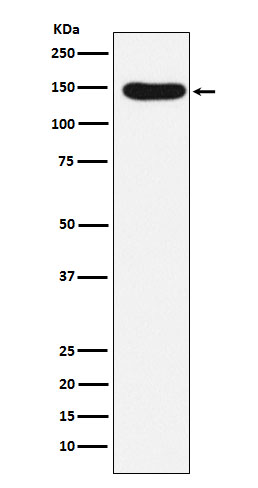
| WB | 1/1000-1/2000 | Human,Mouse,Rat |
| IF | 咨询技术 | Human,Mouse,Rat |
| IHC | 咨询技术 | Human,Mouse,Rat |
| ICC | 技术咨询 | Human,Mouse,Rat |
| FCM | 咨询技术 | Human,Mouse,Rat |
| Elisa | 咨询技术 | Human,Mouse,Rat |
| Aliases | CDHF6; Desmoglein3; DSG3; PVA;;Desmoglein 3 |
| WB Predicted band size | Calculated MW: 108 kDa ; Observed MW: 145 kDa |
| Host/Isotype | Rabbit IgG |
| Antibody Type | Primary antibody |
| Storage | Store at 4°C short term. Aliquot and store at -20°C long term. Avoid freeze/thaw cycles. |
| Species Reactivity | Human |
| Immunogen | A synthesized peptide derived from human Desmoglein 3 |
| Formulation | Purified antibody in PBS with 0.05% sodium azide,0.05% BSA and 50% glycerol. |
+ +
以下是关于Desmoglein 3(Dsg3)抗体的3篇经典文献概览:
---
1. **文献名称**: *"Autoantibodies against a novel epithelial cadherin in pemphigus vulgaris, a disease of cell adhesion"*
**作者**: Amagai, M. et al.
**摘要**: 该研究首次克隆并鉴定了Dsg3为寻常型天疱疮(Pemphigus Vulgaris, PV)的主要自身抗原,发现患者血清中的IgG抗体直接靶向Dsg3.破坏表皮细胞间的黏附,导致皮肤水疱形成。发表于《Cell》(1991)。
2. **文献名称**: *"The role of intramolecular epitope spreading in the pathogenesis of endemic pemphigus foliaceus"*
**作者**: Rock, B. et al.
**摘要**: 通过小鼠模型证明,抗Dsg3抗体(IgG)可通过阻断Dsg3的黏附功能直接诱发天疱疮样皮肤损伤,支持抗体介导的病理机制。发表于《Journal of Clinical Investigation》(1990)。
3. **文献名称**: *"IgG4 is the dominant autoantibody subclass in pemphigus vulgaris and its titers correlate with disease activity"*
**作者**: Spaeth, S. et al.
**摘要**: 发现PV患者中抗Dsg3的IgG4亚型抗体占主导,且其滴度与疾病活动度正相关,提示IgG4在致病中的核心作用。发表于《Journal of Investigative Dermatology》(2001)。
---
这些研究涵盖了Dsg3抗体的发现、致病机制及亚型特异性,为天疱疮的诊断和治疗提供了理论基础。如需具体文献链接或更多细节,可进一步补充说明。
Desmoglein 3 (DSG3) is a transmembrane glycoprotein belonging to the desmoglein family, primarily expressed in stratified squamous epithelia, particularly in the basal and immediate suprabasal layers of the skin and mucous membranes. It plays a critical role in cell-cell adhesion through desmosomes, which maintain tissue integrity. DSG3 antibodies are autoantibodies targeting this protein, most notably associated with pemphigus vulgaris (PV), a rare but severe autoimmune blistering disorder. In PV, IgG autoantibodies bind to DSG3. disrupting desmosomal adhesion and causing acantholysis—separation of epidermal cells—leading to painful mucosal and cutaneous blisters.
DSG3 antibodies are predominantly of the IgG4 subclass, though IgG1 and other subclasses may contribute. Their pathogenicity is confirmed by passive transfer experiments, where injecting these antibodies into mice reproduces blistering. Diagnosis relies on detecting DSG3 antibodies via ELISA or indirect immunofluorescence, with DSG1 antibodies often co-present in mucocutaneous PV. Research suggests epitope-specific responses, where antibodies targeting certain DSG3 domains correlate with disease severity.
Treatment focuses on immunosuppression (e.g., corticosteroids, rituximab) to reduce antibody production. Recent studies explore therapies targeting B cells, plasma cells, or DSG3-specific antibodies directly. DSG3 antibody research also extends to paraneoplastic pemphigus and drug-induced pemphigus, broadening understanding of autoimmune desmosome disruption.
×